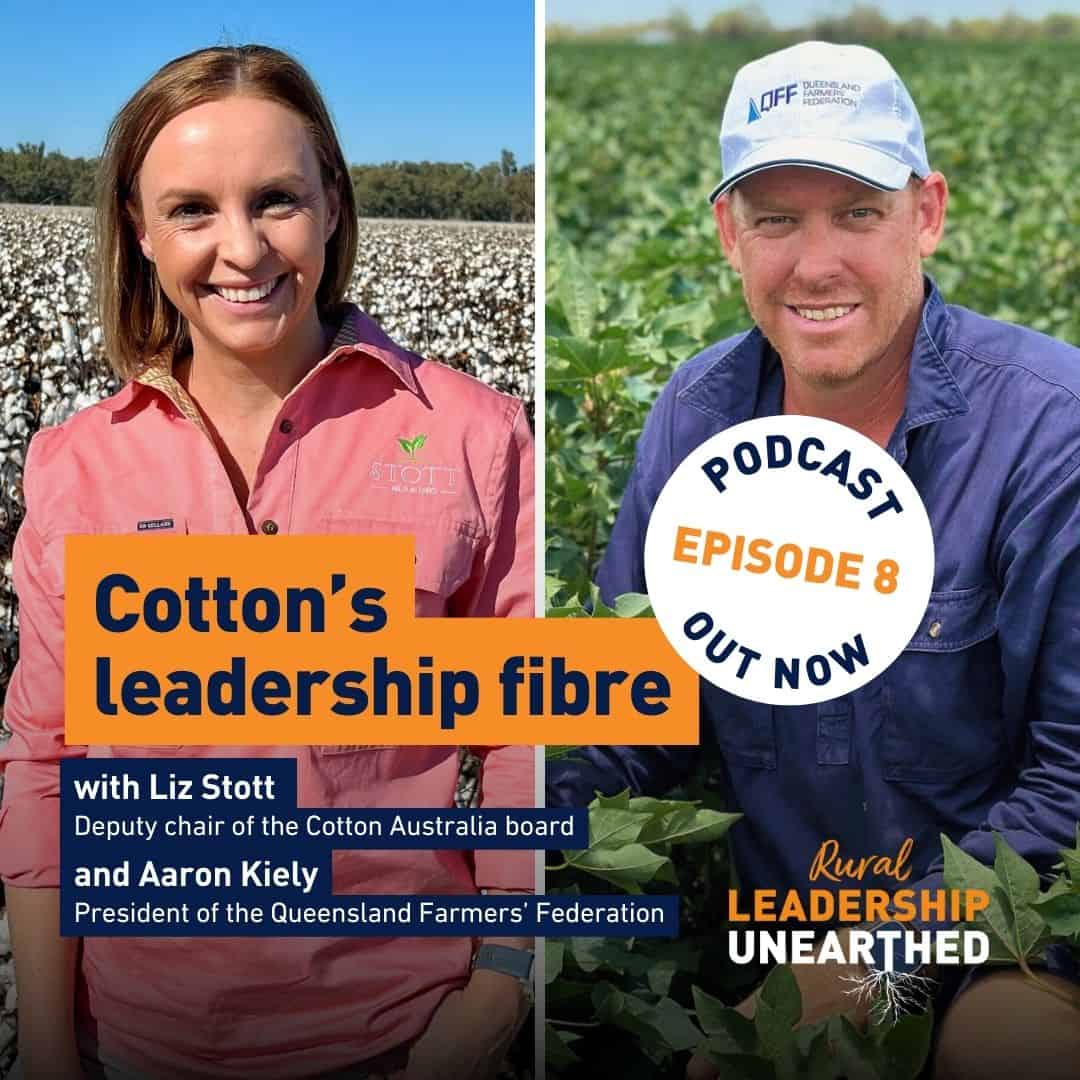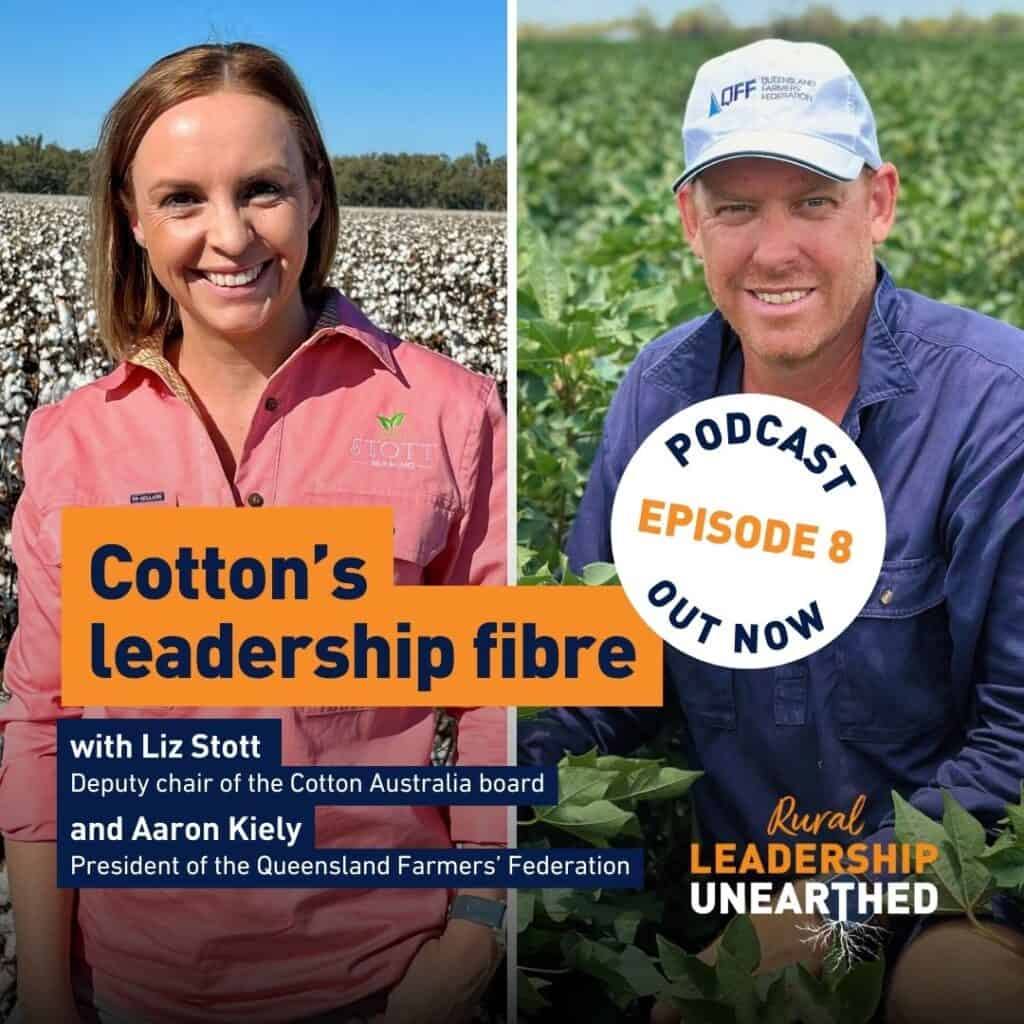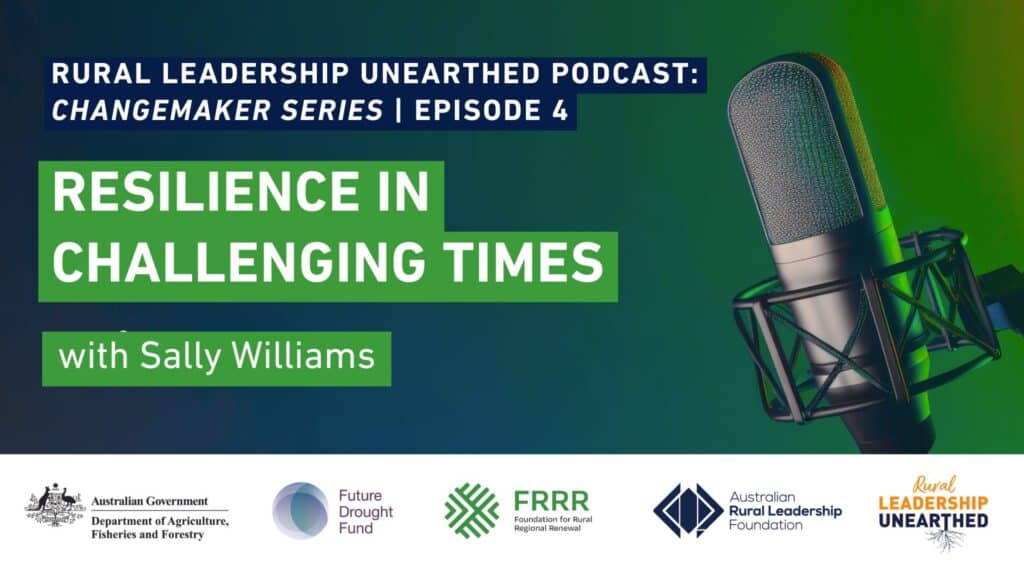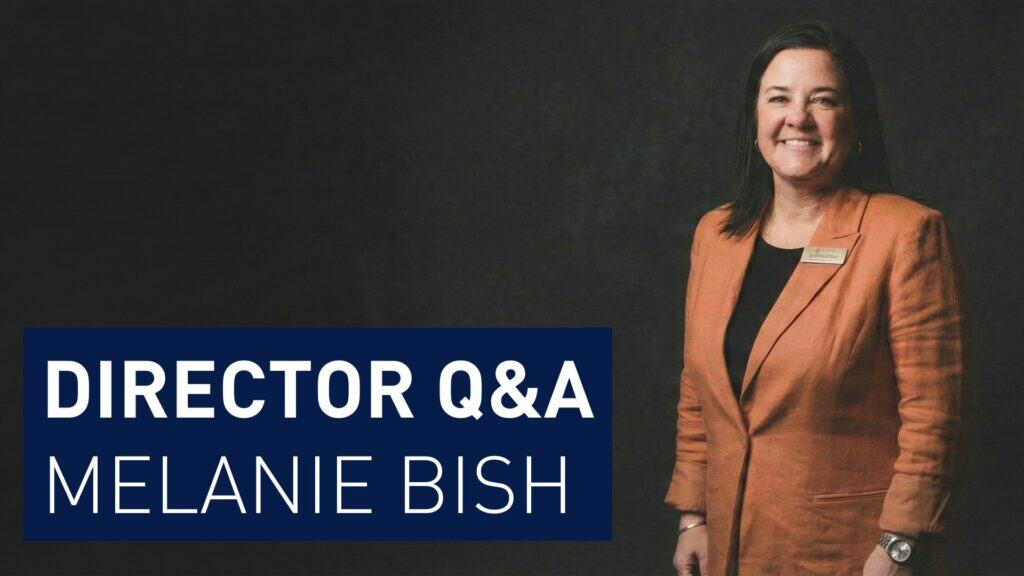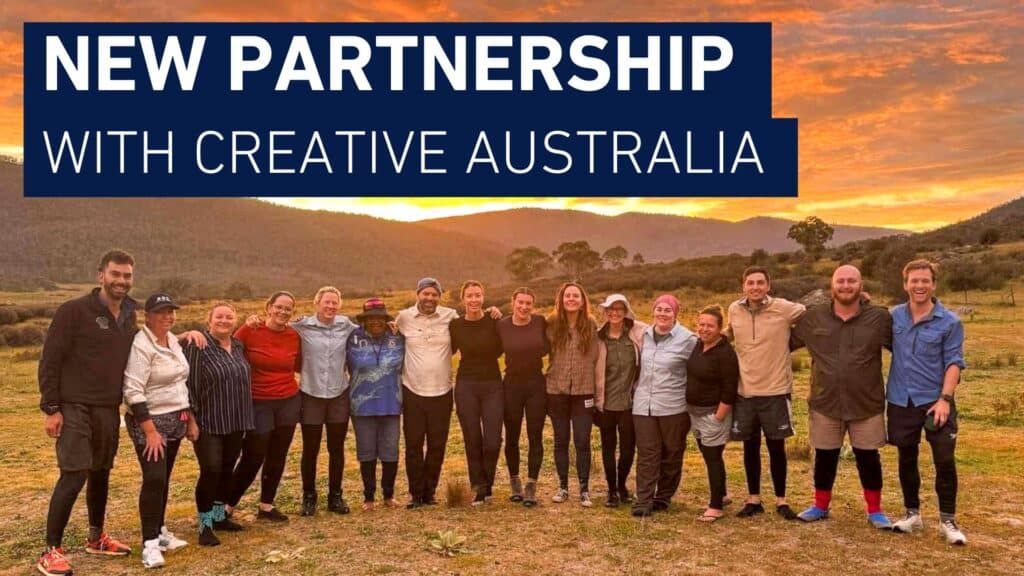The cotton industry is one bursting with opportunities for the people whose livelihoods and communities are connected to the production of this natural fibre.
Liz Stott and Aaron Kiely are both cotton growers, industry leaders and part of the ARLF alumni network. In the latest episode of ARLF podcast, Rural Leadership Unearthed, Liz and Aaron share their stories of advocacy for their industry, and contribution to their communities. Sitting down with ARLF CEO, Matt Linnegar, for this special conversation, Liz – deputy chair of the Cotton Australia board, and Aaron – President of the Queensland Farmers’ Federation, speak about their pathways in the cotton industry.
Liz is a graduate of Course 20, and Aaron of Course 29 of the Australian Rural Leadership Program (ARLP), thanks to scholarships provided by the Cotton Research and Development Corporation. Aaron is also a graduate of the ARLF’s TRAIL Emerging Leaders Program, and of his industry’s Australian Future Cotton Leaders and Cotton20 programs. Both Aaron and Liz share a passion for building up people in agricultural industries to take the whole sector forward.
Matt Linnegar: Tell us about you and what has brought you to leadership roles in the cotton industry.
Liz Stott: I’ve been in the cotton industry for just over 13 years. We grew our first cotton crop in 2009-2010 and it was an absolute shocker, but we knew cotton was a really good crop, and provided the best return on investment in terms of our water so we went again the following year and tripled our area, bought a cotton picker, and haven’t looked back. Off-farm my first job was in Murrumbidgee Irrigation in a communications role. I’ve worked in communications, water policy and public relations for a few different industries, at the rice industry, and did a short stint with the MDBA as one of their first regional engagement officers back in 2017.
Aaron Kiely: I’ve been part of the cotton industry for around 42 years; since birth. I was brought up in St George, Western Queensland, and the family had the opportunity to move to Emerald in the early-mid 80s, where Dad developed our farm. I’m married with a beautiful family; two children, and we’re on our family farming operation here at Emerald.
ML: Liz, your journey to the cotton industry and representation was probably not the most well-trodden one in the sense that you certainly didn’t grow up on a cotton farm.
LS: Yeah, you’re right. I grew up in Canberra; met my husband, Dallas, at a pub in Canberra, and around 12 to 18 months later, I moved out to Leeton. When I first met Dallas, I didn’t even know what an irrigation farm was. I thought he had little sprinklers on his farm … we knew we wanted to be together, so I moved to the family farm. He’s a third generation farmer. My first job, as I said, was with Murrumbidgee Irrigation, and I started there in 2009. That was a really pivotal time for the irrigation industry and the cotton industry because that was basically the beginning of the water reform under the Murray Darling Basin Plan. That was hitting our community for six. Working closely in Murrumbidgee Irrigation, we were leaders in the community in terms of trying to explain what was actually happening with that water reform, and that it wasn’t actually something that was only affecting irrigators. It was going to affect our communities of Griffith, Leeton, and the small communities around the Murrumbidgee Irrigation and Colleambally. So never before, having grown up in the city, had government decisions really potentially threatened to impact my day-to-day life or my business. It really lit a passion within me to do anything I could in terms of leadership and advocacy to make sure that our case was heard.
ML: You both would have heard people talk about the city-country divide. Liz, having straddled two worlds, do you have any insights into that? And what might make a difference in bridging that ‘understanding gap’?
LS: Yeah, I agree, Matt. I think it’s definitely an ‘understanding gap’. In the roles I’ve had, particularly with the rice industry, I find farmers generally feel that there’s a disconnect between the city and the country. I often hear the growers say that we need to make sure that they appreciate what we do. But when you actually go to the city, for the Royal Easter Show in Sydney, for example, everyone wanted to know where they could buy Australian rice. They loved that we grow healthy, sustainably produced food and fibre here in Australia, and they want to support us. But you think about what they’re up to in the cities; they’re not necessarily thinking every day about what happens in rural Australia and on our farms. It’s not that they’re not interested. Everyone’s just busy with their own lives and the things that make them tick and their own passions. And I think sometimes it’s the case that we have to actually educate our own people; our own communities. People don’t hate you, they value what you do, it’s just that they don’t necessarily interact with rural Australia because it’s not part of their day-to-day lives. Just like us, our lives aren’t necessarily interacting with people in the city. I just think we’re very hard on ourselves sometimes as rural communities, that we feel undervalued and feel unappreciated. But when you actually go out there and talk to people, they love what we do. Farmers were rated as one of the most respected professions a few years ago. So everyone loves farmers. It’s just a matter of convincing ourselves sometimes that we are appreciated.
ML: Aaron, you’ve cut a different pathway to your position and your contribution to the cotton industry, and come very much from that rural background. Tell me a bit more about that.
AK: Back in the early 80s, the cotton industry was in a position where it needed to build trust within the communities. We were in a situation with water and chemical use where we had the opportunity to use research and technology and change the dynamics of our industry. Growers took it on board to change how we grow this crop. As a community, we started to build trust. We do need to tell that story to bridge that divide. I feel as growers, we need to tell a story with technology, with social media … we’ve just got to understand what we do and tell our story to the wider community.
ML: And we do need to understand what’s important to people in urban Australia. Do you believe it’s important to have a deeper understanding of what’s going on for them?
AK: I think we do Matt. Life has got busier. The cost of living, for example, has increased. We can say the covid pandemic has changed how we live and what we do. We had a bit of a rest period there as a society, and then we’ve come back out busier than ever. To bridge that gap with rural, remote and regional Australia, we need to tell a story of our community, of how we do it, what our issues are. It could be in the health system. It can be in the irrigation or our community councils in our community, what we’re struggling with. We need to tell the positives of our community, and we need to tell the story, not the negatives, but what we can continue to work on as a whole.
ML: Let’s talk about, for both of you, those leadership pathways. So, Aaron, we know that you went through, for instance, a TRAIL program here with the Australian Rural Leadership Foundation a number of years before then completing the flagship Australian Rural Leadership Program. Tell me a little bit about that pathway and what it meant for you.
AK: I had an opportunity come around with the Australian Future Cotton Leaders program to start off with. From that path, it led to another opportunity where I represented the Australian cotton industry at GrowAG, with 100 delegates across Australia, which then led to the realisation that I need to grow here, to represent our industry and be proud of the industry we’re in. Then it was another shoulder tap to say there’s an opportunity here for the TRAIL program. The TRAIL program, to me, was an absolute game changer. It led me out into meeting a very unique group of people from all different industries, and on the second day, I’m thinking, what am I doing? Like, why am I here? Why do I need to do this? But I think that’s because we were being challenged, by the way of comprehensive peer feedback. I’ve never had that as a way of understanding your own values or growth. That network of people now, still today, you watch them grow, but you still connect with those people. From that opportunity, it led to the flagship program with cohort 29 of the Australian Rural Leadership Program. I had more confidence to be able to take this on. And these opportunities, I’d like to say, don’t come around without the support of our industry. To Cotton Australia, Australian Food and Fibre, these people are investing in our future and leading into that flagship program. This investment from our industry, it was a life changing experience … The learnings throughout the program are very important but the network you get and you build are the people we rely on now. From that as well, it’s put me into a role of being able to mentor and lead in different ways I never thought I would.
LS: A lot of what Aaron just said resonates with me. When I was shoulder tapped as well to apply for the ARLP I’d heard of it, but I just always thought that was for people who were already leaders and already in leadership roles in their industries. At the time, I was working for a company, and I wasn’t in a leadership role. I was trying to see myself outside of being an employee and seeing myself in the cotton industry, because I went to work every day doing my nine to five job, but also was a partner in our farming business. I was off-farm and a bit removed, but what we were doing on farm was in an innovative space, and people were looking to us as leaders in terms of our layouts and automation and things like that.
I definitely had imposter syndrome. I didn’t think I was ready or worthy to be doing that program, and then I was accepted to do the program supported by Cotton Australia and CRDC, I was so grateful for the opportunity to go and learn more about myself. All of that feedback you talked about Aaron, and all the gifts we gave each other at the end of the day … It’s very rare that someone will offer you that constructive feedback. Most of the time, it gets done behind your back, and you never know about it, and you can’t ever take it on board and use it to improve how you operate in your day-to-day life. Over the time of the ARLP we talked heavily around our goals and where we saw ourselves in five years, 10 years, etc. I was really unclear on my pathway, at the time we were trying to have children, but I wrote down as one of my goals to be a director of Cotton Australia. That was the ultimate contribution I could make to industry leadership, in my view, in an advocacy role, which was where my passion was. And I guess it would be a return on investment for Cotton Australia, and CRDC. It took a bit longer than five years, but I ended up on the board of Cotton Australia in 2021. And I see so many wonderful people around us, so many good leaders who I think are walking around not feeling like they’re leaders, but they are. That’s providing a really good platform for our industry going forward, whether it’s Future Cotton Leaders, TRAIL, ARLP, the agribusiness leadership program. There are so many opportunities for people to develop their skills. I can’t ever be thankful enough for that opportunity to grow as a person and get a clearer direction of where I could head outside of just working for an employer.
AK: It just gives you a clear direction on your 5-10 year plan; understanding your values, being able to step into roles that you never thought were possible. For example, I’ve never seen myself stepping into the chair role of Queensland Farmers Federation, representing our industry or industries throughout Queensland. But it’s given me that confidence and that understanding that it is possible for anyone in rural, remote and regional Australia, once you understand yourself and your values.
ML: We know that positional leadership is important, not just for the cotton industry, but right across rural and regional, remote Australia. But if we also accept that leadership itself is a practice and not a position, I’m wondering how you believe your own leadership practice has shifted from where you were before going through those development experiences?
AK: By understanding what my values were, I’ve ended up in a space where, as you say, it’s not about a title. It’s about mentoring the next generation, or the next people to be able to continue to do what we do. And it’s not even based in the cotton industry. I’ve had an opportunity to mentor on the Beef24 program recently. We’re in a corridor where input costs, for example, and logistics, mean we’re all affected by the same issues. From these huge opportunities that I’ve been given, I see a space in agriculture that we need to give these opportunities to others and our time to continue to grow this leadership space. My leadership has now gone to a way of mentoring the next generation to continue what we’re doing… By passing on the opportunities that I’ve been given, I think that’ll build our region and our industry.
LS: I think not being in a leadership position at the time of doing the (ARLP) helped me go into it thinking: how I can develop all of these traits personally to become a better leader in myself and a better leader for those around me? I feel I’ve been able to take on the work we did during the course and the personal development that we were able to do, and build that into myself. I now obviously hope to say I’m using that in my role with Cotton Australia, now I am in a leadership role on the board.
And it’s a bit different, but over the last few years, I’ve sort of found myself using these leadership skills in our local community. Leeton’s not a large town, but the gym I go to has quite a few members, and they’re all local, so I found myself using those skills, and I found a leadership role in the gym. We had a running group, and I was sort of pivotal in getting the numbers into this running group, and we ended up with 20 or 30 people. And the best part about that was seeing people who couldn’t even run a kilometre to complete their five kilometre parkrun or something like that … That feedback was so inspiring and motivating. It led me to go and do my personal training certificates, and I coach at the gym once a week. Building and maintaining relationships and never burning bridges and listening and bringing people with you is a kind of value in in the way I lead now.
ML: I wonder if you would both be prepared to share a moment when your leadership’s been deeply challenged and what did that look like for you?
AK: I think back around five years ago, before the ARLP, I needed to communicate with this group of people to get the outcome I required, but I didn’t feel the outcome was aligned with my values. As a group, you just had to get ball rolling. My biggest challenge was to get clear communication out to get an outcome. So even if you’re doubting it, or you’re struggling with it, you just need to get on with it. It is just learning from the others around you, because that’s why you’re on a committee or a group – to hear everyone’s point of view, and all come to a concise decision.
ML: I’m interested in what you talked about there: how do you sit with a conversation or a process that you’re going through where your own values are challenged, or maybe it’s not a values match?
AK: Where it comes back to is that understanding or deep listening to everybody’s point of view; hearing the full version of everybody’s story on that table, and coming out with an outcome. We’re all going to have different values … If someone asked ‘what would you love to have known 10 years ago in your leadership journey?’ I would have loved to have known my five core values, because it gives you a very clear direction on what you want to be able to do.
LS: I feel my leadership is challenged every day by a nine and five year old. As a parent, you don’t think that you are in a leadership role, but you really are. You’re the coach and the guiding light for these little people who are trying to find their way in the world. I like to try and always take an approach that’s bringing them along, rather than an authoritarian approach. To try to lead by example and help them learn how to behave in certain situations, rather than just tell them this is what they need to do …
The other challenging example in terms of a leadership pathway I thought I might be interested in back six or seven years ago, was politics. I thought it was a way to make a difference in terms of water and our community. I joined a political party. I went for pre-selection for our state election and didn’t win pre-selection but stayed involved. A lot of people were tapping me on the shoulder, saying, Liz, we really need you to get involved. But the more I was the inner workings of politics, I thought, I just don’t think this is for me. There are a lot of really good politicians with great integrity. They’re there for the right reasons. They are there to represent their community … But there are a lot of people there for not really very good reasons. I just thought, I can’t see myself in a position where I can’t trust the people I’m working with. I might have to hold the party line, and it goes against what I feel and believe personally. I realised having integrity is really a strong part of who I am.
I just thought, no, I don’t need that in my life and to make a difference in the issues that are important to me, there’s ways to do that without being a politician.
ML: The cotton sector and the communities that it supports, and that support it, face a range of challenges. How do you both see leadership across the cotton sector, and what does cooperation and collaboration look like?
LS: I think the industry collaborates and cooperates fantastically. As an agricultural industry, we’re often referred to as kind of a shining light in terms of how well we support each other and work across the different areas of the industry. The relationship between Cotton Australia and CRDC, our research part of the industry, is very, very strong, and as a result of that, we have the response to certain challenges. Whether it’s chemical use and water use or, developing our myBMP program (a best management practices voluntary farm and environmental management system) to provide growers with a pathway to demonstrate their sustainability and responsibility around our looking after our environment, our soils, our water use, our safety of our workers, and the correct employment standards for our workers … Going forward, whenever I’ve seen any large social license issues arise in the industry, all I ever see is growers band together to support each other. An issue might be in the northern part of the basin, and southern growers are right behind those northern growers and advocating for them. And about the credibility that they’re highly regulated and they meet all of the standards that are required of them. We also call-out those tiny handful of bad eggs that might have made a mistake over water use. The industry calls them out very strongly and does not condone or support their behaviours at all.
AK: As a grower and part of the CRDC panels, I feel that the cotton industry has always had to be on the front foot with our social license … We believe, as growers, we are very water efficient. We’re always on the front foot with ag tech, or with water probes. And we’re always sharing our learnings as growers and as an industry. As a grower, I’m very proud. Cotton Australia, recently did their Camp Cotton where they bring retail brands from all over the world, take them out on farm and tell the story. They’ve got the cotton industry forum where they bring people in from around the city… The cotton industry in the last 10 years has grown immensely from Central Queensland to southern New South Wales, now expanding … it’s in Kununurra, it’s in the Northern Territory, it’s in northern Australia. So more than ever we need to be on the front-foot as an industry. We are here for the long haul, and I believe we’re the best cotton growers in the world at what we do.
LS: In terms of outside of the cotton industry, Cotton Australia also has really strong connections and working relationships with other advocacy bodies like the National Farmers Federation, QFF, National Irrigators Council, and the New South Wales Irrigators Council. Cotton Australia are part of a bigger picture of the agricultural industry. We will sit around the table at an NFF meeting and be supporting the sheep meat industry, or any other industry who might also be grappling with issues. It’s not only about cotton, it’s about broader good policy and good decisions and a holistic approach to the agricultural sector.
The cotton product that we produce, ultimately, is so highly valued by brands and retailers. They love Australian cotton. It’s a high-quality fibre and the product is why we can tell that story, because it’s the story behind the t-shirt that engages that part of the community that isn’t necessarily connected with the farm, but they love Australian cotton products. So that’s the pathway – collaborate and work with those brands and retailers to help tell that Australian cotton story, and the work we do on farm to be so sustainable and efficient.


